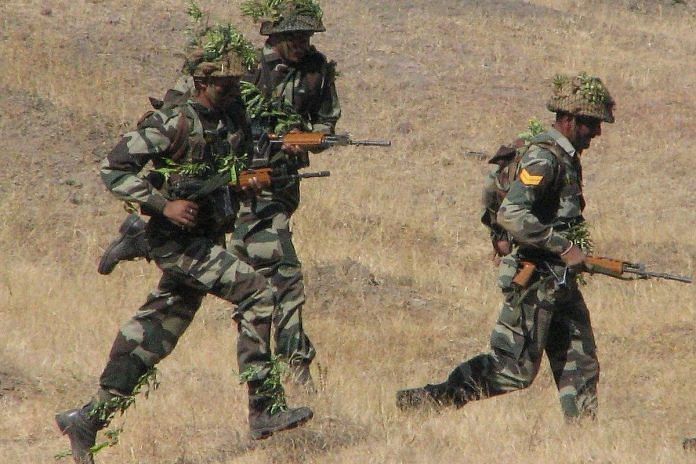If the armed forces are restructured on modern lines, it will enable them to undertake the complex multiple tasks that is expected of them, with lesser manpower.
If the intention to induct civil service aspirants into the armed forces is solely to overcome a critical shortage of military personnel then it is a flawed approach to a far more fundamental problem. The proposal of the Standing Committee of Parliament on Defence that civil service aspirants, in the centre and states, undergo five years of military service prior to joining their cadres is noble in intention, but flawed as a solution.
It is noble that the committee recognises that the shortage of military personnel requires a national solution. But it is also deeply flawed, since it doesn’t get to the core of what caused this shortage. Analysing the root cause is vital to finding a long-term solution to an equally long-term problem.
For starters, the selection of personnel for the armed forces and civil services follow completely different processes. A written exam and an interview are the two prerequisites for getting into the civilian government service. Standards vary from state to state, and sometimes procedures change at the union level too. But, in essence, these are all that are required to enter government service.
Whereas in the armed forces, the selection process for enlisted men and commissioned officers follows a drastically different route when compared to their civilian counterparts. After the exams there are group physical and psychological tests. And most importantly, for officers, individual interviews by the entire services selection board completes the process. The psychological test clarifies whether the person has the ability to lead and manage troops. From among the applicants for commissions, the selection rates are not higher than 10-15 per cent on average.
This is because military service requires a particular kind of aptitude, and the willingness to command unto death. The job requires management, administration, and leadership, possibly until the last breath. Now, a situation may arise wherein civil service aspirants are put through the military selection processes after having cleared central and state procedures, but don’t clear the rigorous tests. It is likely that most will not have the motivation or aptitude for military leadership roles. So, what does that rejection do to their civil service selection? Or self-esteem? Because without undergoing the military selection process, it is downright dangerous to expect civil service aspirants to be able to perform uniformed duties, elementary or advanced.
If incapable people are inducted solely to fill vital gaps, it may result in the loss of lives or a greater leadership calamity. Ultimately, command at any level is about the quality of leadership. That quality will not come with quantity. It will only come from a thorough selection process. Sidelining this selection process will lead to detrimental results overall.
An effort should be made to understand why such shortages occur. Any professional democratic army, anywhere in the world, faces the crisis of the number of officers required being less than those in service. This shortage exists everywhere because the capability required to lead, command, and manage military troops is rare. This is coupled with the fact that militaries are competing against the corporate sector in attracting the brightest among men and women in the requisite age bracket. The shortage exists due to increasing opportunities that offer both financial and intellectual growth. As the world globalises further, and as economies expand, this competition is going to prove to be more critical for armed forces.
Therefore, it is vital that the problem of these shortages be analysed first from within, and then outside solutions are sought. India’s armed forces continue to be structured, and manned, according to pre-1947 patterns. It is a fact that there are greater challenges today than earlier. But it is also a fact that society is far more educated and qualified than before, providing a greater pool to select from.
The coupling of an educated recruitment base, and available technologies, suggests that the armed forces need to be restructured on modern lines, and not continue on the inherited patterns they currently run on. This will enable armed forces to undertake the multiple complex tasks that are expected of them, with lesser manpower, through greater use of advanced technologies. Realisation that more is not always better is the first step to overcoming shortages in the armed forces.
The purpose behind this Standing Committee proposal is, therefore, commendable, but the approach is flawed only because the shortage of officers is not short-term thing. It is a social phenomenon that explains why people are not approaching selection centres in the required numbers. Long-term solutions are required in terms of restructuring and quality of life.
As I’ve mentioned earlier in ThePrint, a separate pay commission is required for the military. We need to look at armed forces as a standalone, not in a larger government structure. A separate pay commission will be able enhance intellectual and professional growth, and enable people to achieve their personal targets. They should have the ability and resources to reach there.
However, if the Standing Committee proposal has a hidden agenda of improving civilian governance by introducing military-type discipline, then it needs to be treated differently.
Manvendra Singh is Editor, Defence and Security Alert magazine & a BJP MLA from Rajasthan.




It seems to me that the armed forces (in particular the Indian Army) are far too large in terms of manpower. A rationalization exercise ought to be undertaken with a view to reducing the size of the Army, if possible to around 1 million men while at the same time trying to increase the number of troops earmarked for offensive operations (the strike corps). This will require a shift toward more and better equipment to improve mobility (E.g. heavy lift strategic transport aircraft, personnel carriers, Etc.). It will also reduce the number of officers required, thereby closing the deficit. Our generals have traditionally focused far too much on numbers.